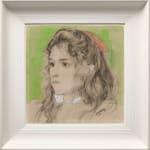Jan Toorop (1858-1928)
Jan Theodoor Toorop was born on 20 December 1858 in Purworejo on the Island of Java in the Dutch East Indies (now Indonesia). He was a descendant of a Dutch-Indonesian father and a British mother, who moved to the Netherlands at the age of eleven. In 1880, Toorop enrolled at the Rijksakademie in Amsterdam. From 1882 to 1886, he lived in Brussels, where he became closely involved with Les XX (Les Vingts), a group of progressive artists centered around James Ensor (1860-1949). After his marriage to the British Annie Hall in 1886, Toorop alternated his time between The Hague, Brussels, and England. Beginning in 1890, Toorop also spent time in the Dutch seaside town of Katwijk aan Zee. During this period he developed his own unique Symbolist style, with dynamic, unpredictable lines based on Javanese motifs, highly stylized willowy figures, and curvilinear designs. Toorop died on 3 March 1928 in The Hague.
For Toorop, European culture became an addition to the foundation he had been exposed to as a child in Indonesia. Like Vincent Van Gogh, Toorop became a socialist sympathizer after observing the people at work in the slag heaps of the Borinage, a horrific landscape more vivid than any hell imagined by the Symbolists. Poetry by Maurice Maeterlinck and Emil Verhaeren became the source of inspiration for Toorop and his contemporaries. From 1882 through 1889, Toorop lived intermittently in Ixelles, near Brussels. Joining the newly formed Lex XX (Les Vingt) in 1884, he was immediately part of the inner circle of the “revolutionaries”: James Ensor and Fernand Khnopff. As the sole Dutch member of Les XX, Toorop forged important relationships between his peers in Belgium and The Netherlands. After meeting the British student Annie Hall (1860-1929) in Brussels, Toorop split his time between The Netherlands, England and Belgium. In April 1890, the couple settled in the Dutch coastal town Katwijk aan Zee, jumpstarting a new artistic endeavor. Notwithstanding an absence from Holland for nearly a decade, Toorop was considered the most important Dutch avant-garde artist at the time, with international connections and aspirations.
Soon after returning to the Netherlands, Toorop cofounded the Haagse Kunstkring, where he organized the first retrospective exhibition of Vincent van Gogh, followed by a group show of Les XX in 1892. That same year, Sar Péladan visited The Netherlands, luring Toorop to join his Salon de la Rose+Croix and ushering in his foray into symbolism. Soon, seductive, fatal women, symbols of sensuality and destroyer of man, entered Toorop’s emblematic vocabulary. Embracing his colonial East Indies heritage of tropical vegetation, carvings and Hindu iconography, Toorop began his most important symbolist drawing The Three Brides, now in the Kröller-Müller Museum, Otterlo. After its completion in 1893, Toorop returned to portraiture, employing his personal symbolism: the soul is revealed in a fantasy, embodying different types of beings rather than the formality of a portrait.
Provenance
With François Buffa & Fils., AmsterdamPrivate collection, The Netherlands



